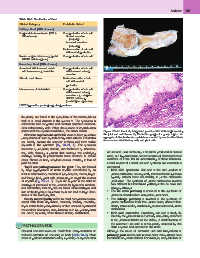Page 801 - Robbins Basic Pathology by Vinay Kumar, Abul K. Abbas, Jon C. Aster
P. 801
Arthritis 787
Table 20–3 Classification of Gout
Clinical Category Metabolic Defect
Primary Gout (90% of cases) Overproduction of uric acid
Enzyme defects—unknown (85% to Normal excretion
90% of cases) (majority)
Increased excretion
Known enzyme defects—e.g., partial
HGPRT deficiency (rare) (minority)
Underexcretion of uric acid
with normal production
Overproduction of uric acid
Secondary Gout (10% of cases) Overproduction of uric acid A
Associated with increased nucleic with increased urinary
excretion
acid turnover—e.g., leukemias
Chronic renal disease Reduced excretion of uric
acid with normal
Inborn errors of metabolism production
Overproduction of uric acid
with increased urinary
excretion, e.g., complete
HGPRT deficiency
(Lesch-Nyhan syndrome)
HGPRT, hypoxanthine guanine phosphoribosyl transferase.
frequently are found in the cytoplasm of the neutrophils as B
well as in small clusters in the synovium. The synovium is
edematous and congested and contains scattered mononu- Figure 20–21 Gout. A, Amputated great toe with white tophi involving
clear inflammatory cells. When the episode of crystallization the joint and soft tissues. B, Photomicrograph of a gouty tophus. An
abates and the crystals resolubilize, the attack remits. aggregate of dissolved urate crystals is surrounded by reactive fibroblasts,
mononuclear inflammatory cells, and giant cells.
Chronic tophaceous arthritis evolves from repetitive
precipitation of urate crystals during acute attacks. The urates of uric acid. Less commonly, uric acid is produced at normal
can heavily encrust the articular surfaces and form visible rates, and hyperuricemia occurs because of decreased renal
deposits in the synovium (Fig. 20–21, A). The synovium excretion of urate. For an understanding of these influences,
becomes hyperplastic, fibrotic, and thickened by inflamma- a brief review of normal uric acid synthesis and excretion is
tory cells, forming a pannus that destroys the underlying warranted.
cartilage, leading to juxtaarticular bone erosions. In severe • Uric acid synthesis. Uric acid is the end product of
cases, fibrous or bony ankylosis ensues, resulting in loss of
joint function. purine catabolism; consequently increased urate synthesis
typically reflects some abnormality in purine nucleotide
Tophi are pathognomonic for gout. They are formed production. The synthesis of purine nucleotides involves
by large aggregations of urate crystals surrounded by an two different but interlinked pathways: the de novo and
intense inflammatory reaction of lymphocytes, macrophages, salvage pathways.
and foreign-body giant cells, attempting to engulf the masses • The de novo pathway is involved in the synthesis of
of crystals (Fig. 20–21, B). Tophi can appear in the articular purine nucleotides from nonpurine precursors.
cartilage of joints and in the periarticular ligaments, tendons, • The salvage pathway is involved in the synthesis of
and soft tissues, including the ear lobes, nasal cartilages, and purine nucleotides from free purine bases, derived from
skin of the fingertips. Superficial tophi can lead to large ulcer- dietary intake and by catabolizing nucleic acids and purine
ations of the overlying skin. nucleotides.
• Uric acid excretion. Circulating uric acid is freely fil-
Gouty nephropathy refers to renal complications asso- tered by the glomerulus and virtually completely resorbed
ciated with urate deposition, variously forming medullary in the proximal tubules of the kidney. A small fraction of
tophi, intratubular precipitations, or free uric acid crystals and the resorbed uric acid is subsequently secreted by the
renal calculi. Secondary complications such as pyelonephritis distal nephron and excreted in the urine.
can occur, especially when there is urinary obstruction. Although the cause of excessive uric acid biosynthesis in
primary gout is unknown in most cases, rare patients have
PATHOGE NESIS identifiable enzymatic defects. For example, complete lack of
Elevated uric acid levels can result from overproduction or
reduced excretion of uric acid, or both (Table 20–3). Most
cases of gout are characterized by a primary overproduction

